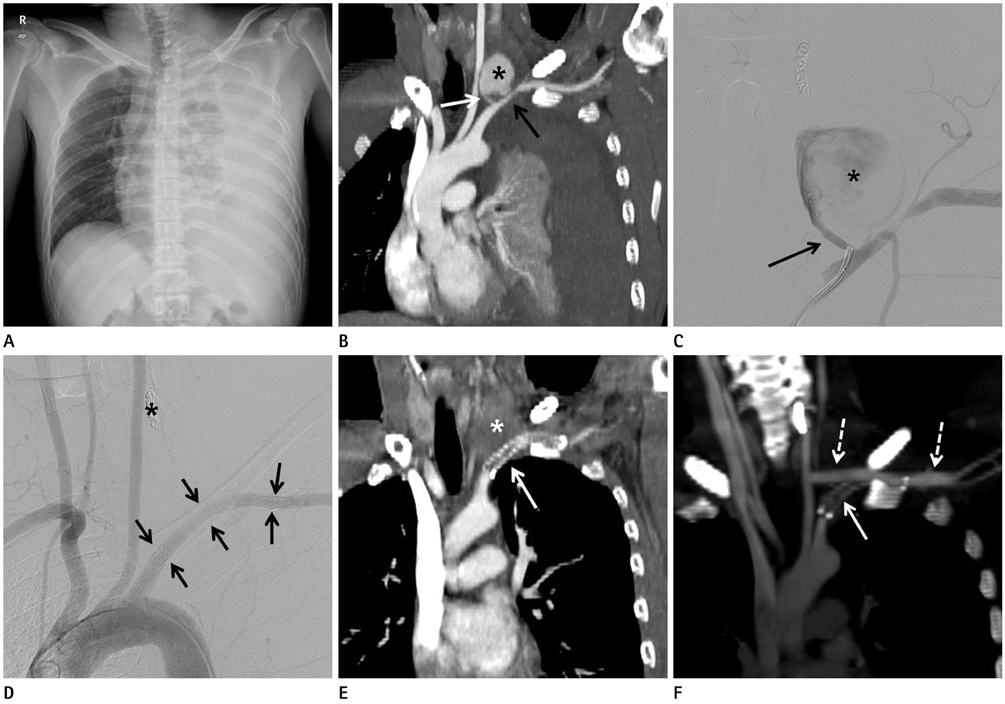J Korean Soc Radiol.
2014 Apr;70(4):247-250. 10.3348/jksr.2014.70.4.247.
Interventional and Surgical Treatment of a Hemothorax Caused by a Ruptured Vertebral Artery in a Patient with Neurofibromatosis Type I
- Affiliations
-
- 1Department of Radiology, Chosun University College of Medicine, Gwangju, Korea. dhk0827@chosun.ac.kr
- 2Department of Cardiovascular Surgery, Chosun University College of Medicine, Gwangju, Korea.
- KMID: 2041933
- DOI: http://doi.org/10.3348/jksr.2014.70.4.247
Abstract
- We report a case of a massive hemothorax arising from a ruptured vertebral artery aneurysm in a patient with neurofibromatosis type 1 suffering from sudden onset of dyspnea. The vertebral artery aneurysm was treated with endovascular coil embolization. Then, an open thoracotomy was performed to evacuate the hematoma.
MeSH Terms
Figure
Reference
-
1. Hirsch NP, Murphy A, Radcliffe JJ. Neurofibromatosis: clinical presentations and anaesthetic implications. Br J Anaesth. 2001; 86:555–564.2. Niimi M, Ikeda Y, Kan S, Takami H, Furui S, Takeshita K. Re: spontaneous rupture of an intercostal artery due to neurofibromatosis type I disease treated by percutaneous embolization. Cardiovasc Intervent Radiol. 2002; 25:160–161.3. Kim SJ, Kim CW, Kim S, Lee TH, Kim KI, Moon TY, et al. Endovascular treatment of a ruptured internal thoracic artery pseudoaneurysm presenting as a massive hemothorax in a patient with type I neurofibromatosis. Cardiovasc Intervent Radiol. 2005; 28:818–821.4. Hongsakul K, Rookkapan S, Tanutit P, Pakdeejit S, Songjamrat A, Sungsiri J. Spontaneous massive hemothorax in a patient with neurofibromatosis type 1 with successful transarterial embolization. Korean J Radiol. 2013; 14:86–90.5. Hall RJ, Miller GA, Kerr IH. Ruptured bronchial artery aneurysm mimicking aortic dissection. Br Heart J. 1977; 39:909–910.6. Miyazaki T, Ohta F, Daisu M, Hoshii Y. Extracranial vertebral artery aneurysm ruptured into the thoracic cavity with neurofibromatosis type 1: case report. Neurosurgery. 2004; 54:1517–1520.7. Salyer WR, Salyer DC. The vascular lesions of neurofibromatosis. Angiology. 1974; 25:510–519.8. Lehrnbecher T, Gassel AM, Rauh V, Kirchner T, Huppertz HI. Neurofibromatosis presenting as a severe systemic vasculopathy. Eur J Pediatr. 1994; 153:107–109.9. Chang WC, Hsu HH, Chang H, Chen CY. Spontaneous hemothorax caused by a ruptured intercostal artery aneurysm in von Recklinghausen's neurofibromatosis. J Formos Med Assoc. 2005; 104:286–289.10. Dominguez J, Sancho C, Escalante E, Morera JR, Moya JA, Bernat R. Percutaneous treatment of a ruptured intercostal aneurysm presenting as massive hemothorax in a patient with type I neurofibromatosis. J Thorac Cardiovasc Surg. 2002; 124:1230–1232.
- Full Text Links
- Actions
-
Cited
- CITED
-
- Close
- Share
- Similar articles
-
- Spontaneous Hemothorax Caused by Rupture of an Intercostal Artery Aneurysm in Neurofibromatosis Type I I : A Case Report
- Spontaneous Extracranial Vertebral Artery Dissection in a Neurofibromatosis 1 Patient with Bilateral Intrathoracic Spinal Meningoceles around the Scoliosis: Report of an Autopsy Case
- Spontaneous Massive Hemothorax in a Patient with Neurofibromatosis Type 1 with Successful Transarterial Embolization
- Spontaneous Hemothorax in a Patient with Type I Neurofibromatosis
- Endovascular Treatment of a Ruptured Internal Mammary Artery Pseudoaneurysm Presenting as Massive Hemothorax in a Patient with Type I Neurofibromatosis


